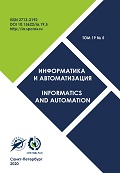Methodology of Structure-aimed Analysis of Problem Situations in Organization Systems for Industry Branches
Abstract
Systems analysis (SA) was widely used in solving of complex problems. At the initial stages of SA problems and goals are analyzed and the structures of problems/goals (SP/SG) are formed. Decision-makers have to be sure the formed aim-realizing systems (ARS) can achieve goals of SG and these goals are right. But analysis is based on expert methods. Therefore quality of SP/SG is not very high. That is why scientific foundations of SA are not supposed to have been completely formed. Methodology based on logical and linguistic simulation of structure-aimed analysis of problem situations is a step in the direction of formalization of the initial stages of SA and improvement quality of their results. It allows to eliminate errors in structures, make reliable complex solutions and perform correct synthesis of ARS.References
Published
2002-02-01
How to Cite
Lukianova,. (2002). Methodology of Structure-aimed Analysis of Problem Situations in Organization Systems for Industry Branches. SPIIRAS Proceedings, 1(1), 297-315. https://doi.org/10.15622/sp.1.21
Section
Articles
Authors who publish with this journal agree to the following terms:
Authors retain copyright and grant the journal right of first publication with the work simultaneously licensed under a Creative Commons Attribution License that allows others to share the work with an acknowledgement of the work's authorship and initial publication in this journal.
Authors are able to enter into separate, additional contractual arrangements for the non-exclusive distribution of the journal's published version of the work (e.g., post it to an institutional repository or publish it in a book), with an acknowledgement of its initial publication in this journal.
Authors are permitted and encouraged to post their work online (e.g., in institutional repositories or on their website) prior to and during the submission process, as it can lead to productive exchanges, as well as earlier and greater citation of published work (See The Effect of Open Access).






